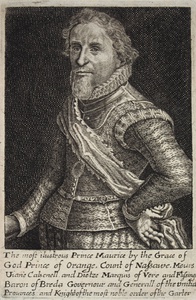| Method | Copper engraving |
| Artist | after Pieter Isaacsz |
| Published | [c. 1600] |
| Dimensions | Image 93 x 72 mm, Plate 115 x 76 mm, Sheet 121 x 80 mm |
| Notes |
A scarce, half-length portrait of Maurice of Nassau, turned to the left, wearing a fine doublet with lace collar and sash. This is after a print by Boëtius Adamsz Bolswert, which was in turn inspired by a painting of Pieter Isaacsz. Inscription to lower margin: "The most ilustrous Price Maurice ... most noble of the Garter" Maurice of Nassau, Prince of Orange (1567 - 1625) succeeded his father, William I 'the Silent', in 1585, taking the role of Stadtholder of all provinces within the Dutch Republic, except for Friesland. Pieter Isaacsz (1569-1625) was a Danish-born painter, printmaker, draftsman, as well as an art dealer and diplomat. In 1578 his father brought the family from Denmark to Amsterdam. Pieter apprenticed with Hans van Aachen, travelling with his teacher to Venice, Florence, Rome, and even Munich, Keulen and Frankfurt am Main. After his training, he moved back to Amsterdam, but often visited Copenhagen. Eventually he moved back to Copenhagen and was appointed court-painter and art dealer to King Christian IV and diplomat. Boëtius Adamsz Bolswert (c.1585-1633) was a renowned copperplate engraver born in Friesland. He was the elder brother of the engraver Schelte à Bolswert. He apprenticed with Abraham Bloemaert, and in around 1610 Bolswert worked in Amsterdam, and sometimes also in Utrecht. Reproductions of large landscapes by David Vinckboons and Gillis van Coninxloo III were among his early successes. In 1615 and 1616 he was licensed by the Dutch State-General to engrave the portraits of Michiel Jansz van Mierevelt, and in 1618 he depicted the ceremonial funeral-bed of the newly-deceased Philipp Wilhelm, Prince of Orange. In 1620 he was admitted into the Guild of St Luke in Antwerp. In 1624 he collaborated with the Brussels Jesuit Father Herman Hugo (1588–1629) on the production of the highly popular devotional book Pia Desideria. In 1627, whilst working in Brussels, he published his own devotional book Duyfkens ende Willemynkens Pelgrimagie, which was later translated into French. Bolswert established two publishing houses, one in Holland, and a larger one in Belgium. He was influenced by Philip Galle and similar engravers, as well as the painter Rubens' rendering of form. after Hollstein Dutch, Bolswert, 385. Condition: Strong impression. Trimmed close to the plate mark. |
| Framing | unmounted |
| Price | £60.00 |
| Stock ID | 46077 |

